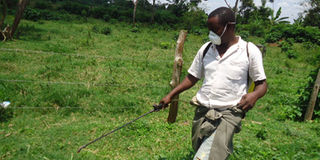What farmers need to know about using herbicides

Though it may be cost saving, there are number of issues that come with the use of chemicals. These involve proper management of the chemicals as well as protection against the potentially harmful effects. Photo by Fred Muzaale.
What you need to know:
Growing crops comes with the ever present menace of weeds, which compete with them for nutrients in the soil and space. Often, the weeds harm the crops and lead to less yields. Herbicides are a way to deal with the weeds.
Herbicides are chemicals that kill weeds or prevent their normal growth. Today, many farmers have embraced the use of herbicides to do the job instead of weeding manually.
This is because the use of chemicals offers a cheaper and faster way of killing weeds. But for effective results, farmers need to know how to use herbicides properly.
Types of herbicides
There are two types—selective and non-selective. While non-selective herbicides like Glyphosate kill all types of weeds, selective herbicides kill or stunt a targeted type of weed with little or no harm to other weeds.
The latter include those that kill or stunt narrow-leaved weeds or broad-leaved weeds like 2,4-D and Amine.
Another type is the one that is applied any time before weeds emerge from the soil, for example, Simazine and Butanil-S. This one, if applied, sterilises the seeds and prevents them from germinating for a period of two to six months.
If applied, it helps the crops to grow without any competition or interference from weeds until a stage when they can no longer be affected by the weeds.
Cost of herbicides
The retail price of Glyphosate is between Shs14,000 and Shs16,000 a litre. A 20 litre jerrycan of 2, 4-D is Shs80,000.
When and how to apply herbicides
Twaha Kakooza, a garlic and maize farmer with farms in Kayunga and Mukono districts, suggests spraying herbicides when daytime temperatures have risen and when the dew on the weeds has dried.
Therefore, he says, it is advisable to spray after 10am. He explains that spraying weeds while there is still dew on them or immediately after it has rained would dilute the herbicides. But if it rains about two hours after application, the herbicide will not be washed away and will still be effective.
While spraying, ensure that the leaves or foliage are thoroughly sprayed. Also, it is important to follow instructions. As with all chemical products, it is important to comply with the given instructions on the label.
In particular, pay attention to the correct dosage and method of application. After using a knapsack sprayer, wash it thoroughly with soap or a detergent to remove the herbicide residues, which might kill non-targeted plants when it is used another time.
Application rates
This depends on to the type of weed on which the herbicide is being used. For example, when using Glyphosate on annual weeds the recommended rate is one to one and a half litres per hectare or 150-200ml per 20 litre of water.
But the dosage rate changes when applying the same herbicide to perennial weeds like Kikuyu and couch grass to three to four litres per hectare or 300-400ml per 20 litres of water.
Protection
Because of the effects they have on human health due to their toxicity, herbicide application should be done when a farmer is wearing appropriate protective gear or clothing.
The protective clothing that covers the whole body can be got at Shs150,000 while a disposable nose musk can be got at Shs500 each.
Advantages and disadvantages of using herbicides
Herbicides can be used in cases where manual removal of weeds may destroy the crops.
So, the application of herbicides in, most cases, is enough whereas the other methods will have to be continually used.
Herbicides are relatively cheap, and most of the time cheaper than hiring labour for manual weeding. So, a farmer saves money when he/she uses herbicides instead.
Despite the advantages, there are disadvantages associated with use of herbicides.
Some are being harmful to the soil since they are non-biodegradable.
They are toxic and can cause illnesses and even death. Glyphosate, for instance, can cause eye, skin and respiratory problems.
Herbicides can pollute water sources as they can be carried by runoff rain water or go into the soil and eventually find their way into the water sources.




